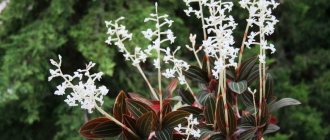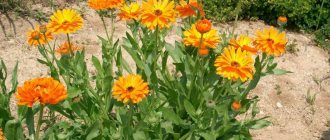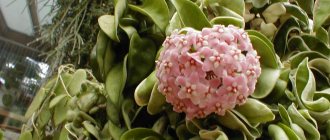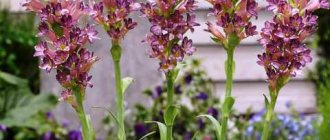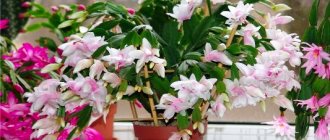This unusual vine flower has been decorating the estates of many gardeners for four hundred years. Everything about it is beautiful: patterned, carved-like foliage, dazzlingly beautiful flowers.
Author of the article
Maxim Sverchkov
Professional biologist and breeder with extensive experience and experience.
Due to its ability to wrap around obstacles encountered in the path of its shoots, it is widely used for landscaping various vertical structures. It decorates balconies, slopes of rocky hills, terraces, and gazebos. How to properly care for a plant, where to plant it and how to grow it is described in this article.
Botanical description
Maurandia is a climbing flowering plant. In regions with warm climates it is grown as a perennial, in temperate latitudes as an annual. To better understand what it looks like, it is recommended to look at a photo of azarina.
It has strongly branching shoots that are 3-7 m long. Thin petioles extend from them, with which the stems cling to the supporting surface. Depending on the variety, the leaves can be fleecy or smooth, whole or with serrated edges. The plates are rounded-triangular with a pointed end, with a heart shape at the base. The foliage is a rich green hue.
The flowers are solitary, tubular, located in the axils. They are quite large in size, located along the entire stem, right up to the tip. Petals can be of various shades. The most common colors are violet, pink and magenta. Less often they are snow-white, blue or yellow.
Two-color buds are very rare. Flowering is long, lasting from June to September. After its completion, a fruit-box with seeds is formed.
Growing Azarina climbing seedlings and planting them in open ground
Azarina climbing is an uncommon guest on the household plots of residents of the Russian Federation, but it is undeservedly deprived of the attention of gardeners. The plant looks extremely attractive and has the ability to decorate the most inconspicuous flower bed. In addition, it is undemanding in care, the main thing is to follow the basic rules; its shoots grow quickly, forming a thick, green coating. Azarina is a flowering plant that is used for vertical or ground cover gardening. You can grow the plant yourself, from seeds sold in special stores. How to prevent mistakes at the stages of germination and picking of seedlings? All the secrets of growing are already known.
Common varieties
There are many types and varieties of Maurandia. Let's consider the most beautiful of them that can be grown in the climatic conditions of Russia.
Climbing
The most common varieties are:
- Bridget White with snow-white flowers;
- Joan Loraine with purple petals;
- Mystic Rose with bright raspberry buds;
- Red dragon with scarlet flowers;
- Sky blue with blue petals.
The leaves resemble the greenery of ivy. Stems 3-4 m. This is the most common species grown in Russian gardens.
Prostrate
In the wild it is found in northeastern Spain and southwestern France. The most popular variety is Sierra Nevada. Its leaf blades are jagged along the perimeter, with a fleecy cover. Tubular flowers reach 4 cm, painted yellow. This species is able to withstand short frosts down to -15 degrees.
Antirhinotsvetkovaya
It has a fairly short stem length, it varies between 1.5-2.5 m. Small leaves are heart-shaped. The flowers reach 3 cm. The colors of the petals can be varied (blue, pale purple, red or snow-white).
Barclay
Lives in the wild in Mexico. 3.5 m long. Bell-shaped flowers grow up to 7 cm. The color of the petals can be pinkish, crimson or lilac. The pharynx has a faded tone.
Blushing
The length of the shoots is up to 3.5 m, but they can climb up the support only 120 cm. The leaf plates are fleecy and grow up to 8 cm. The flowers can reach 7 cm, the petals are painted in a soft pink tone, and there are dull spots on the snow-white throat .
Purpusa
The flowers are funnel-shaped and reach 5 cm. The color of the petals can be carmine or pale purple.
Wislecena
It has large flowers, painted in a soft purple or heavenly tone. An exception is the Red Dragon variety, which has bright ruby petals.
Sowing seedlings
Step by step sowing:
- Prepare the substrate at the end of January-beginning of February. To do this, mix peat, sand, leaf soil and humus in equal quantities.
- Disinfect the soil by heating it in the oven and pouring it with a solution of potassium permanganate.
- Wait a day, then scatter the seeds over the surface, press them lightly, cover them with a 5 mm layer of sand, and spray them with a spray bottle.
- Cover the container with film or glass.
Seedlings should be kept at a temperature of +15…+20 degrees. Remove film and glass daily for ventilation.
Growing from seeds
Growing from seeds is a rather lengthy process - this is what many gardeners think, but not in the case of climbing azarina. No patience is required - no more than 4 months pass from the appearance of the first shoots to the onset of flowering. The plant grows rapidly during this period. The process of sowing and caring for seedlings is extremely simple and even a beginner can handle it.
The following instructions will help you sow correctly:
- • sowing should be done in February-March in order to obtain an adult plant setting buds by May; • seeds have a high germination rate, but you should not worry if there are no germinations within a month - the germination process is quite long; • ten week old seedlings can be planted in open ground (provided there are no night frosts).
Soil requirements
Azarina climbing can grow in poor soil, but all the beauty of the plant can be seen only if optimal conditions are provided for it. By providing nutritious soil, rapid growth of healthy shoots is observed.
Optimal soil composition for sowing:
- • garden soil; • humus; • sand; • high-moor peat (for looseness).
All of the listed components should be combined in equal parts and mixed thoroughly, then poured with boiling water or baked in the oven.
Advice! Seedlings do not take well to overwatering, so care should be taken to arrange drainage at the stage of preparing containers for sowing.
A drainage layer 1 cm thick should be placed in the seedling boxes.
Sowing
No preliminary seed preparation is required. They are laid out on moist soil and lightly embedded in the soil.
Attention! The germination rate of climbing azarina seeds is high, so the seeds should not be sown densely. If there is not enough free space, the seedlings may turn out to be defective, and difficulties may also arise during the picking process.
You should not sprinkle the seeds with substrate. To ensure optimal humidity, the boxes should be covered with glass and placed in a bright place.
The following instructions for caring for seedlings:
1. After the first shoots appear, the glass should be removed for a while (no more than 1-2 hours a day).
2. After a week, the glass is removed and the room temperature is reduced to 17 degrees.
3. For normal growth, seedlings need additional lighting - 14-16 hours a day.
4. Watering should be moderate; when flooded, a black leg may form (the disease can destroy all seedlings).
Interesting information! What to do if seedlings have not appeared a month after sowing? If there is no doubt about the quality of the material for sowing, they are probably dormant. The bowls with soil and seeds should be placed in the refrigerator for 20 days, and then returned to the windowsill with good lighting. This shock should awaken the seeds.
Picking
Picking is the most critical stage in the process of germinating Azarina climbing from seeds. This is due to the fact that the plant reacts quite painfully to any damage to the root system. In this regard, experienced gardeners recommend planting seedlings in peat tablets or paper pots, with which the prepared plant can be planted on a personal plot.
The pots are filled with the soil used for sowing. It is recommended to pick when the plant has 3-4 full leaves. The main task of the gardener is to carefully remove each seedling, because the plant is “sick” after injuries to the root system. After 10 days, the seedlings are fed with complex fertilizer. For normal growth, lighting should be provided for 12 hours and a temperature of 20 degrees.
It is important to gradually “harden off” the seedlings by gradually exposing the pots to the street. The duration of exposure to air on the first day should not exceed 2 hours.
Disembarkation
Planting outdoors can be done when the temperature outside stabilizes, the risk of frost disappears, and the seedlings become stronger. This occurs approximately 10-12 weeks after sowing the seeds. Step-by-step planting in the ground on the site:
- Dig holes at a distance of 60 cm.
- Place seedlings in the holes.
- Install a support in the form of metal wire or mesh with medium-sized cells.
- When the seedlings get used to the new place a little, tie them to a support.
If you plant azarina correctly, it will bloom at the end of June.
Reproduction by cuttings
This method of breeding helps save time on growing the azarin plant. In winter, it is necessary to cut off a part of the stem about 20 cm long from a strong and healthy maurandia. The seedling should be placed in a container with water or a sand-peat mixture. When it produces roots, you can transplant it into a pot. When the weather outside stabilizes, plant the cuttings in the garden.
Pests and diseases
Azarina climbing is very hardy and resistant to all kinds of diseases. However, she has one dangerous enemy - aphids. To avoid meeting this uninvited guest, you can periodically spray azarina leaves with an infusion of tansy, garlic, onion peel or pine needles.
If there is a large infestation of insects, the plants should be treated with an insecticide .
As you can see, the beautiful climbing azarina will give you very little trouble. You just need to grow seedlings of this wonderful vine in advance and provide it with a suitable place in your garden. And then, thanks to love and care, the azarina will soon turn into a luxurious climbing vine, completely strewn with bright and delicate flowers.
And for the most curious, we suggest you watch a video about climbing azarin
Care requirements
The plant needs feeding. For the first time, organic matter (infusion of mullein or chicken droppings) must be added 12-15 days after planting in the garden. Next, complex mineral mixtures are applied every 10 days.
It is very important to know how to water azarina. It is a moisture-loving plant, so it needs regular moisture. However, you need to know moderation in everything; there should be no stagnation of liquid. Otherwise, various diseases may develop. It is recommended to water as the top layer of soil dries.
For better penetration of air and nutrients to the roots, the soil must be loosened regularly. Weed control is also important. Otherwise, they will take away useful elements.
To make the shoots lush, it is advisable to do periodic pinching. It is better to tie stems that are too long to a support so that they do not break under a gust of wind. All care consists of these simple manipulations. It is quite simple and even inexperienced gardeners can do it.
Where is the best place to plant a flower?
Since this is a climbing plant, experienced gardeners advise planting it in places where it is necessary to decorate arches, fences and balconies. A hanging basket would be a great option to watch the hanging plant bloom.
As already mentioned, the soil should be neutral and light, permeable to air and without stagnant moisture. It is necessary to avoid windy places to avoid injury to the plant.
IMPORTANT! Planting of climbing azarina must be carried out with the presence of support.

